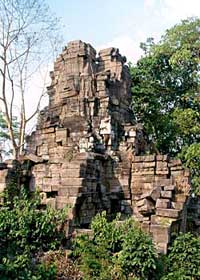 The signs were auspicious. It was the first day of the annual water festival in the Cambodian capital and one of my closest friends in Kathmandu, architect and conservationist John Sanday, was being awarded the Order of the British Empire.
The signs were auspicious. It was the first day of the annual water festival in the Cambodian capital and one of my closest friends in Kathmandu, architect and conservationist John Sanday, was being awarded the Order of the British Empire.
It was pouring when the time came for British Ambassador Stephan Bridges, representing Queen Elizabeth, conferred the award on Sanday (pictured, right) whose tall, lanky figure and good-natured persona is familiar to many in Nepal.
Although most Nepalis are not aware of the important work John has done to preserve and enhance Nepal's cultural heritage, this important recognition should spread awareness. John Sanday's name will now be an integral part of Nepal's cultural history and recognition of his heritage conservation work in Nepal and Cambodia.  Most recipients of the knighthood normally have to travel to London to receive the medal which would then be pinned onto his jacket by Queen Elizabeth at Buckingham Palace, but John has never been one for convention for convention's sake. He kept wondering if it wouldn't be possible to receive the award in Cambodia, where so much of his work and dedication has been centred over the last 12 years. He also wanted to share his acclaim with a dedicated group of Cambodian technicians and architects with whom he had worked so closely and formed lasting friendships.
Most recipients of the knighthood normally have to travel to London to receive the medal which would then be pinned onto his jacket by Queen Elizabeth at Buckingham Palace, but John has never been one for convention for convention's sake. He kept wondering if it wouldn't be possible to receive the award in Cambodia, where so much of his work and dedication has been centred over the last 12 years. He also wanted to share his acclaim with a dedicated group of Cambodian technicians and architects with whom he had worked so closely and formed lasting friendships.
John Sanday has been working on the 12th Century temples of Preah Khan and Ta Som since 1992 after he finished his big Hanuman Dhoka project in Nepal. The Killing Fields were still fresh and festering in everyone's mind and he had to build his team from scratch since most engineers and technicians had been killed by the Khmer Rouge.  When he started working in Preah Khan, he and his team often encountered suspicious gun-toting teenagers in the jungle which were encroaching on the temple complexes and had to be judiciously cut back in order to save some important 1,000-year-old stone sculptures and temples in the world famous Angkor complex.
When he started working in Preah Khan, he and his team often encountered suspicious gun-toting teenagers in the jungle which were encroaching on the temple complexes and had to be judiciously cut back in order to save some important 1,000-year-old stone sculptures and temples in the world famous Angkor complex.
John Sanday's old friends from Siem Reap and his conservation team were present at the ambassador's residence in Phnom Penh for the award ceremony. They were joined by Azedine Beschaouch of the UNESCO in Paris, who for the last decade has been involved in the campaign to protect Angkor. Much of Sanday's work in Nepal was also carried out under UNESCO auspices, although the main sponsor in Cambodia is the World Monument Fund.
Since John Sanday started his career in Nepal and has worked on conservation projects all over the country, one hopes that he will also be appropriately honoured in Nepal as well. His restoration of the Hanuman Dhoka Palace in Kathmandu is John's best known work in Nepal. He had discovered a few old craftsmen who remembered the traditional technique for making temple bricks and his reconstruction of Hanuman Dhoka was not just rebuilding the monument but rediscovering the masonry and carpentry techniques with which they were built.
John also worked on buildings in Bhaktapur and Patan, propping up a sliding Swayambhu, and he is now restoring four monasteries in Mustang and one in Tukche.
Young Nepali and Cambodian architects have benefited from John's skills as well as his passion for restoration. His expertise and his willingness to share his craft has ensured that the work of restoration will now pass on to a new generation of local architects, conservationists and engineers. Although he received his medal in Cambodia, the award also honoured his achievements in Nepal.
There will surely be a party waiting for John when he returns to Kathmandu.


